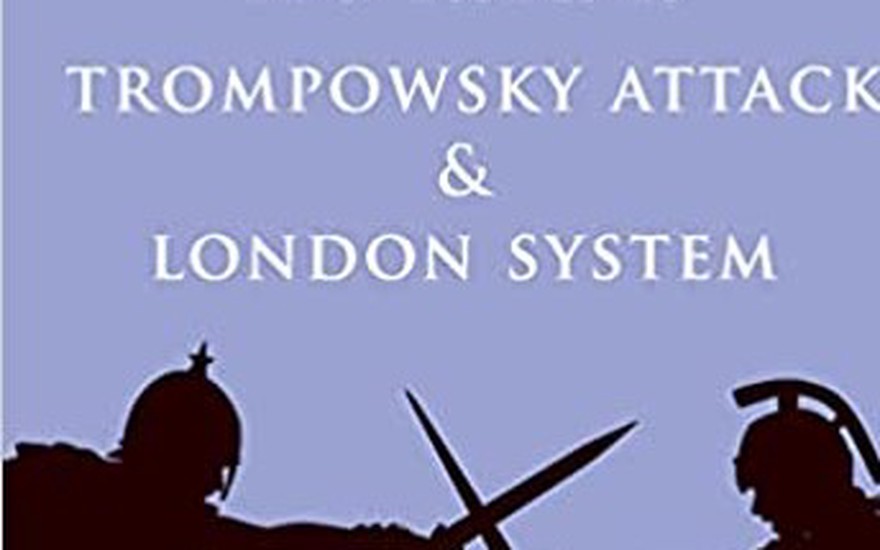
Review: Trompowsky Attack & London System by Viktor Moskalenko
This is a review by FM James Vigus of Viktor Moskalenko's Trompowsky Attack & London SystemTrompowsky Attack & London System
by Viktor Moskalenko
New in Chess, 200 pages
Sample pages available on the publisher's website
Introduction
Subtitled 'new ideas, dynamic strategies and powerful weapons', this book presents a set of aggressive methods for White after:
1 d4 Nf6 2 Bg5 - the Trompowsky
1 d4 f5 2 Bg5 - which the author calls the Trompowsky versus the Dutch
1 d4 d5 (or 1...Nf6) 2 Bf4 - the London System
The Trompowsky comes first and receives the most space. This used to be my favourite opening with White. I'll come back to that at the end.
Moskalenko regards the Trompowsky and London as thematically very closely related. Treating them together also gives the reader an option against both 1...Nf6 and 1...d5.
Pros and cons
My feelings about this book by the prolific Ukranian grandmaster are mixed.
On the very positive side, reading it has made me want to play the Trompowsky again, which I didn't expect. (Everyone on Lichess: you have been warned...) The 46 annotated games include some gems. 11 of them are by Moskalenko himself, showing that he practices what he preaches. Especially in these games, the author's enthusiasm for the 'd4 specials' is apparent. The promise of 'new ideas' is certainly kept.
My reservations are: (i) that Moskalenko's assessments are sometimes over-optimistic for White, and (ii) that options for Black are often omitted.
I suspect that (ii) could have been addressed by stating clearly that the book does not attempt comprehensive coverage. It functions more like one of Everyman's 'Chess Developments' works, providing inspiration and novelty rather than an encyclopedic primer. It's a little unfortunate in this respect that the back cover refers to a 'complete opening repertoire'. Valuable though the book is, readers would do best to supplement it with other sources.
While some of the gaps in the coverage are problematic, I do see the rationale for this approach: space is saved to present different options for White, which is useful in openings where flexibility is so vital. But all this could have been stated explicitly.
What is in the book?
The chapter titles are rather abstract, so I'll give the outline from the index:
Part 1 - The Trompowsky 1 d4 Nf6 2 Bg5
Chapter 1: 2...c5
3 d5 e5 - game 1
3...e6 - game 2
3...b5 - game 3
3...d6 - game 4
3...Qb6 4 Nc3 Qxb2 5 Bd2 Qb6 6 e4 d6 7 f4 e6 / g6 / Nbd7 / Qd8 - game 5
7...e5 - game 6
3...Ne4 - game 7
3 Bxf6!? exf6 - game 8
3...gxf6 4 d5 Qb6 5 Qc1 - game 8
5 Nd2!? - game 9
Chapters 2, 3 - 2...Ne4 3 Bf4
3...c5 4 f3 Nf6 - game 10
4...Qa5+ 5 c3 Nf6 6 d5 Qb6 - game 11
6...d6 / 6...e6 - game 12
3...d5 4 f3 Nf6 5 Nc3 Bf5 (5...e6/5...c5) 6 g4! - game 13
6 e3 - game 14
4 e3 Bf5 5 f3 Nf6 6 Nc3 - game 14
4...c5 5 Bd3 - game 15
5 Nd2 - game 16
4...c6/4...e6/4...g6 - game 17
Chapter 4 - 2...e6
3 e4 h6 4 Bxf6 Qxf6 5 c3 - game 18
5 Nc3 - game 19
3 Nd2 h6 - game 20
3...c5 - game 21
Chapter 5 - 2...d5
3 Nd2 / 3 e3 - game 22
3 Bxf6 exf6 - game 23
3...gxf6 - game 24
Chapter 6 - 2...g6
3 Bxf6 / 3 Nf3 / 3 Nc3 - game 25
Chapter 7 - The Dutch - 1 d4 f5 2 Bg5
2...d5 / 2...Nf6 / 2...d6 / 2...c5 - game 26
2...g6 - game 27
2...h6 - game 28
Part II The London System: d4, Bf4, Nf3
Chapter 8 - 1 d4 d5 Bf4
2...c5 3 e3 cxd4 4 exd4 Nc6 5 c3 Nf6 / 5...Bf5 / 5...f6 - game 33
3...Nc6 4 c3 Bf5 - game 31
4...Qb6 5 Qb3 c4 6 Qc2 Bf5 / 6...e5 - game 29
6...Nf6 7 Nd2 - game 30
2...Nf6 3 e3 c5 4 Nc3 - game 30
4 c3 Qb6 5 Qb3 Nc6 6 Nd2 c4 7 Qc2 - game 30
4...Nc6 5 Nd2 Bf5 - game 31
5...Bg4 - game 32
5...cxd4 6 exd4 Bf5 / 6...Bg4 / 6...g6 - game 33
3 Nf3 c5 4 e3 Nc6 5 Nbd2 e6 6 c3 - chapter 9, games 36, 38, 39
5...Qb6 6 dxc5 Qxb2 7 Rb1 Qc3 8 Bb5 e6 / 8...Qxc5 / 8...Bd7 - Game 34
8...g6 - game 35
Chapter 9
1 d4 d5 2 Bf4 e6
3 Nf3 Nf6 4 e3 Be7 - game 36
4...c5 5 Nbd2 Nc6 6 c3 Be7 - game 36
6...Bd6 - game 38
6...cxd4 / 6...Nh5 - game 39
4...Bd6 5 Nbd2 Bxf4 - game 37
5...0-0 6 c3 b6 / 6...c5 - game 37
2...c6 3 e3 - game 40
2...Bf5 3 c4 / 3 e3 - game 41
Chapter 10
1 d4 Nf6 2 Bf4
2...b6 - game 43
2...e6 3 Nf3 c5 4 e3 Qb6 / 4...Nc6 - game 42
4...Be7 / 4...b6 - game 43
2...d5 3 e3 g6 4 Nf3 - game 44
4 Nc3 - game 46
2...g6 3 e3 Bg7 - game 45
3 Nc3 d5 / 3...d6 - game 46
Layout
All analysis is embedded within illustrative games. Various symbols signalling 'trick', 'puzzle', 'weapon', 'plan', statistics' and so on liberally sprinkle the text. To my mind these clutter the text somewhat, but in some cases they are useful visual aids. The content never becomes particularly variation-heavy.
A mixed bag
I'm going to focus on the first part - the Trompowsky. I've picked out some cases in which Moskalenko's material is particularly interesting, yet lacks attention to Black's counter-ideas.
a) Let's start with game 1, in which Moskalenko unleashed 1 d4 Nf6 2 Bg5 c5 3 d5 e5 4 d6(!). This idea was new to me. I like it a lot.
But Moskalenko implies that this means Black cannot reach a Czech Benoni structure. That is not the case: 3...d6 4 Nc3 e5 5 e4 Be7 does the trick. Now Black is threatening ...Nxd5. Rapport has played this way with Black. This should not terrify White, but we need to be prepared for it.
b) Game 4 sees the author in action again, with a sparkling win against Ipatov (2009) beginning 1 d4 Nf6 2 Bg5 c5 3 d5 d6 4 Nc3 a6 5 a4 g6 6 e4 Bg7 7 Nf3 0-0 8 Be2. This has transposed to a Schmid Benoni, in which White has played the relatively unusual Bg5. Moskalenko believes this favours White.
However, if Black omits ...a6 and deviates with 4...g6 5 e4 Bg7 6 Nf3 0-0, White can't safely continue with the Moskalenko-style 7 Be2 because of 7...b5! (if 8 Bxb5 Nxe4).
c) After 1 d4 Nf6 2 Bg5 Ne4 3 Bf4 Moskalenko considers two moves: 3...d5 and 3...c5. These are indeed Black's main tries. But if the reader is surprised with:
3...d6 intending 4 f3 Nf6 5 e4 e5 6 dxe5 Nh5
or 3...e6 4 Nd2 Bd6
or 3...Nc6,
what to do?
d) After 1 d4 Nf6 2 Bg5 Ne4 3 Bf4 d5 one of the options given is the ultra-aggressive 4 f3 Nf6 5 Nc3. Here the gambit 5 e4 is also mentioned as a possibility - but now 5...dxe4 6 Nc3 Nd5!? (unmentioned here) could come as a nasty surprise.
e) Continuing with 5 Nc3, the sensible reply 5...e6 is strangely labelled 'TRICK' (as though Black were falling into a trap; after 6 e4 just a few more moves are given. Once upon a time books used to quote a game Cooper-Gufeld to claim that Black is more than fine here - it is not straightforward for White to develop the knight on g1. I'm prepared to believe White is really better, as Moskalenko claims, but I'd like to see some analysis to prove it.
f) After 1 d4 Nf6 2 Bg5 e6 3 Nd2 h6 4 Bh4 Moskalenko comments that 4...d5 is 'almost forced'. This is an example of over-optimism. '4...c5?! is already a mistake' due to 5 e4. But here the move 5...g5 is not considered. It may well be good for White, but it has been played by Aronian, Ponomariov and Leko. Besides, 4...Be7 is a solid alternative (unmentioned).
g) Another form of extreme optimism is the citation of statistics instead of analysis. In game 21 we have 1 d4 Nf6 2 Bg5 e6 3 Nd2 c5 4 e3 cxd4 5 exd4 Be7 6 Ngf3 b6 7 c3 Bb7 8 Bd3 and now one line runs 8...d6 9 Bxf6 Bxf6 10 Qe2 Nd7 11 h4!? 'with an attack. 11 games, +7 for White.' I think this is a clever recommendation. I understand from the subsequent comment that I should look up Miladinovic's games. However, the position is sharp and I'd appreciate some grandmasterly guidance here.
Conclusion
There is some excellent material in this book. It is a rich source of inspiration and sharp 'weapons' - but to be handled with care.
Bibliography (postscript for the Trompowsky connoisseur)
Times change. Like many British players I was inspired to take up the Trompowsky by the games of Julian Hodgson. In my last ever tournament game with it, I ventured it against Hodgson himself. It was going ok, but I panicked on move 23. I did have occasional success with it against slightly lesser grandmaster opposition.
I learnt the opening from Andrew Martin's book Secret Weapons. I then studied Joe Gallagher's The Trompowsky. That was a wonderful book, full of exciting Hodgson victories. Meanwhile, my own secret weapon was Wolfgang Gerstner's Der Trompowski-Angriff (1995), supplemented by three booklets in the 'Trends' series published in the UK. I never tracked down Hodgson's Secrets of the Trompowsky (I see that he has more recently produced a video on the opening on Ichess). By the time Peter Wells's Winning with the Trompowsky appeared, impressive though it looked, I had long given up the opening and was taking a long break from chess.
That now seems more or less ancient history, and I understand why Moskalenko doesn't refer to any of that material. His sources include the cluster of three books on the Trompowsky in 2013-14 by Richard Pert, Richard Palliser and Cyrus Lakdawala, as well as Dmitry Kryavin's 2018 work.
An omission I do find puzzling, though, is the Chesspublishing website, where under the rubric 'd-pawn specials' the top theoretician Richard Palliser regularly posts Trompowsky analysis, adding to the fine previous material by Eric Prie and others.
More blog posts by Minckwitz

Review: The Perfect Pirc-Modern by Viktor Moskalenko
This is a review by FM James Vigus of Moskalenko's The Perfect Pirc-Modern
Review: Some instructional and training works
Review by FM James Vigus of recent training/calculation books
Review: Basman's Folly (1 g4) by Lakdawala and Hansen
Review by FM James Vigus of Lakdawala & Hansen's book on the Grob